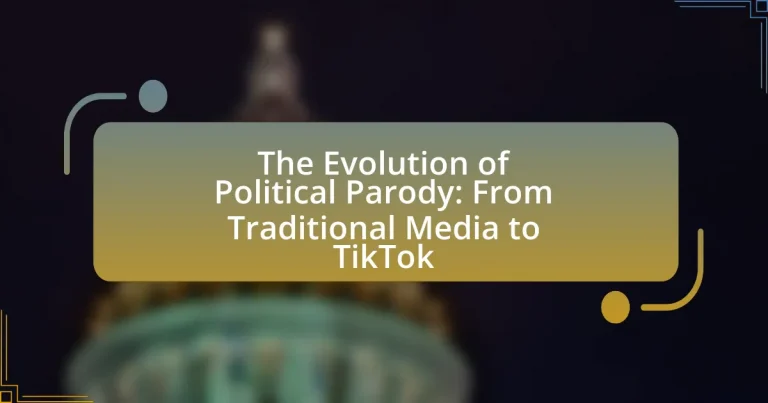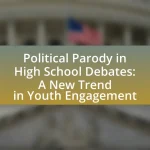The article examines the evolution of political parody, tracing its transition from traditional media forms, such as print and television, to contemporary digital platforms like TikTok. It highlights how political parody has adapted to changing media landscapes, becoming more immediate and accessible, particularly among younger audiences. Key historical influences, such as the French Revolution and the Watergate scandal, are discussed, along with the significant role of traditional media in shaping early forms of political satire. The article also explores the unique features of TikTok that facilitate political parody, the implications of this evolution for public discourse, and best practices for creators in producing effective political satire.
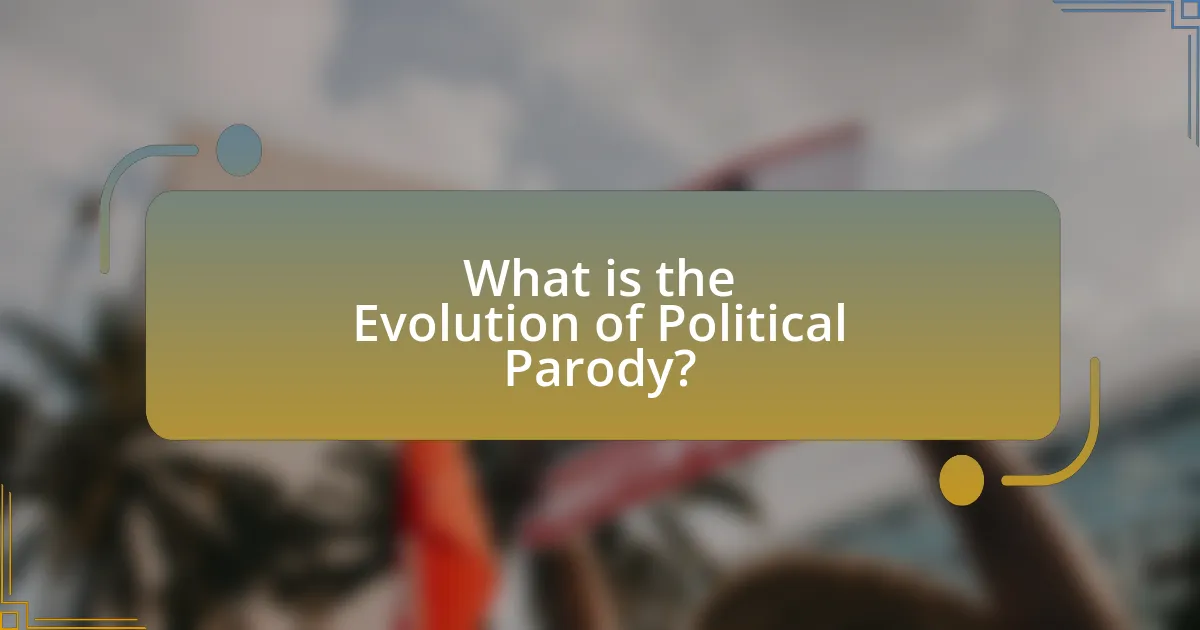
What is the Evolution of Political Parody?
The evolution of political parody has transitioned from traditional media forms, such as print and television, to digital platforms like social media and TikTok. Initially, political parody was primarily found in satirical newspapers and television shows, such as “Saturday Night Live,” which began in 1975 and became known for its comedic takes on political events and figures. With the rise of the internet in the late 1990s and early 2000s, platforms like YouTube allowed for a broader dissemination of political parody, enabling creators to reach wider audiences without the constraints of traditional media.
In recent years, TikTok has emerged as a significant platform for political parody, leveraging short-form video content to engage younger audiences. This shift reflects changes in media consumption habits, where immediacy and relatability are prioritized. The adaptability of political parody to various formats and platforms illustrates its enduring relevance in shaping public discourse and opinion.
How has political parody changed over time?
Political parody has evolved significantly from traditional media formats to digital platforms like TikTok. Initially, political parody was primarily expressed through print media, television shows, and live performances, with notable examples including “Saturday Night Live” and editorial cartoons that critiqued political figures and policies. As technology advanced, the rise of the internet and social media transformed political parody into a more immediate and accessible form, allowing for rapid dissemination and engagement. Platforms like YouTube and Twitter enabled creators to produce and share short, impactful parodies that could quickly go viral, reflecting real-time political events and public sentiment. The emergence of TikTok further accelerated this trend, as its short-form video format encourages creativity and spontaneity, allowing users to engage with political content in a humorous and relatable manner. This shift illustrates how political parody has adapted to changing media landscapes, becoming more participatory and diverse in its expressions.
What historical events influenced the development of political parody?
The development of political parody has been significantly influenced by events such as the French Revolution, the rise of mass media in the 19th century, and the Watergate scandal. The French Revolution (1789-1799) marked a pivotal moment where satire became a tool for critiquing authority, as pamphlets and caricatures targeted the monarchy and political figures. The advent of mass media in the 19th century, particularly newspapers and political cartoons, allowed for broader dissemination of parody, exemplified by the work of artists like Thomas Nast, who used humor to address social issues and political corruption. The Watergate scandal in the 1970s further propelled political parody into mainstream culture, as television shows like “Saturday Night Live” began to use satire to comment on political events, shaping public perception and engagement. These historical events collectively established a framework for political parody as a means of social commentary and critique.
How did traditional media shape the early forms of political parody?
Traditional media significantly shaped early forms of political parody by providing a platform for satire and commentary on political events and figures. Newspapers and magazines in the 18th and 19th centuries, such as “The Spectator” and “Punch,” utilized illustrations and written satire to critique political leaders and policies, making political parody accessible to a wider audience. This accessibility allowed for the dissemination of humorous takes on serious issues, influencing public opinion and encouraging political discourse. The use of caricatures and satirical articles became a powerful tool for social and political critique, establishing a tradition that would evolve with the advent of new media forms.
Why is political parody significant in society?
Political parody is significant in society because it serves as a tool for social critique and political commentary, allowing individuals to express dissent and challenge authority. This form of satire can highlight the absurdities and contradictions within political systems, making complex issues more accessible and engaging for the public. Historical examples, such as the political cartoons of the 18th and 19th centuries, demonstrate how parody has influenced public opinion and sparked discussions about governance and policy. Furthermore, with the rise of digital platforms like TikTok, political parody has evolved, reaching wider audiences and fostering a new generation of politically aware citizens.
What role does political parody play in public discourse?
Political parody serves as a critical tool in public discourse by facilitating the critique and examination of political figures and policies. It allows individuals to express dissent, challenge authority, and engage in political dialogue in a manner that is often more accessible and entertaining than traditional forms of political commentary. Research indicates that political parody can enhance political engagement, as seen in studies showing that exposure to satirical content increases viewers’ political knowledge and encourages them to participate in civic activities. For instance, a study published in the journal “Political Communication” found that audiences who consume political satire are more likely to discuss political issues and vote, demonstrating the significant impact of parody on public engagement and discourse.
How does political parody impact political engagement and awareness?
Political parody significantly enhances political engagement and awareness by making complex political issues more accessible and relatable to the public. This form of satire simplifies intricate topics, allowing audiences to grasp key messages quickly, which can lead to increased interest in political discourse. For instance, studies have shown that individuals exposed to political parody are more likely to discuss political issues and participate in civic activities, as evidenced by research from the Pew Research Center, which found that 62% of young adults reported being more politically active after engaging with political satire. This indicates that political parody not only entertains but also serves as a catalyst for informed political participation.
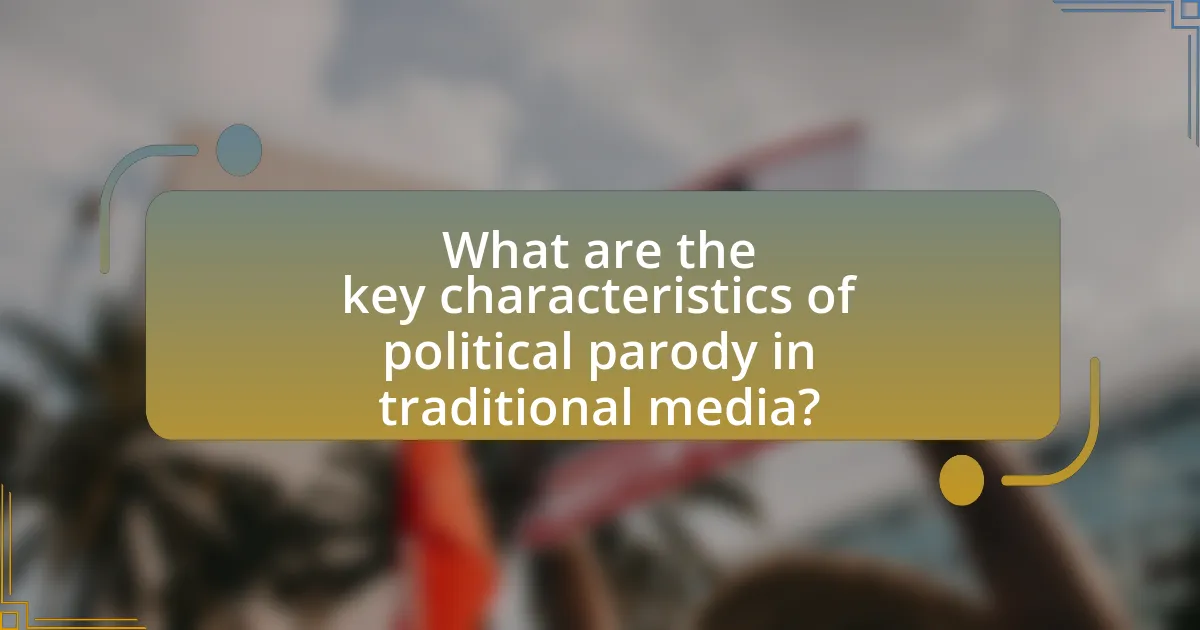
What are the key characteristics of political parody in traditional media?
Political parody in traditional media is characterized by satire, exaggeration, and humor aimed at critiquing political figures and events. This form of parody often employs recognizable formats such as sketches, cartoons, and satirical news programs, which allow audiences to engage with political commentary in an entertaining manner. For instance, programs like “Saturday Night Live” and “The Daily Show” utilize comedic elements to highlight the absurdities of political situations, thereby fostering public discourse. Additionally, traditional media parody often relies on cultural references and current events to resonate with viewers, making it a powerful tool for social critique and political engagement.
How did television and print media contribute to political parody?
Television and print media significantly contributed to political parody by providing platforms for satire and commentary that shaped public perception of political figures and events. Television programs like “Saturday Night Live” and “The Daily Show” utilized sketch comedy and satirical news formats to critique politicians, influencing audience opinions and engagement with political discourse. Print media, through editorial cartoons and satirical articles, offered visual and written commentary that highlighted political absurdities, making complex issues more accessible and relatable to the public. For instance, editorial cartoons by artists like Thomas Nast in the 19th century effectively used humor to expose corruption, demonstrating the historical impact of print media on political parody.
What notable examples of political parody emerged in television history?
Notable examples of political parody in television history include “Saturday Night Live,” “The Daily Show,” and “The Colbert Report.” “Saturday Night Live,” which began in 1975, has featured political sketches that satirize politicians and current events, significantly influencing public perception of political figures. “The Daily Show,” launched in 1996, uses satire to critique news and politics, shaping the landscape of political commentary. “The Colbert Report,” airing from 2005 to 2014, parodied conservative punditry, highlighting the absurdities of political discourse. These shows have played pivotal roles in blending entertainment with political critique, demonstrating the power of parody in shaping political dialogue.
How did print media utilize satire and parody in political commentary?
Print media utilized satire and parody in political commentary by employing humor and exaggeration to critique political figures and policies. Publications like “The Onion” and “Mad Magazine” used caricatures and absurd scenarios to highlight the flaws and contradictions in political discourse, making complex issues more accessible to the public. For instance, during the 19th century, satirical cartoons in newspapers such as “Punch” lampooned politicians, influencing public opinion and encouraging civic engagement. This approach not only entertained readers but also fostered critical thinking about governance and societal norms, demonstrating the power of satire as a tool for political commentary.
What techniques are commonly used in traditional political parody?
Traditional political parody commonly employs techniques such as satire, exaggeration, irony, and caricature. Satire critiques political figures or policies through humor, often highlighting their flaws or absurdities. Exaggeration amplifies certain traits or actions of politicians to absurd levels, making them more recognizable and humorous. Irony contrasts expectations with reality, revealing contradictions in political discourse. Caricature visually distorts features of political figures to emphasize their characteristics, making them instantly identifiable. These techniques have been historically used in mediums like cartoons, skits, and written works to engage audiences and provoke thought about political issues.
How do humor and satire function in political parody?
Humor and satire function in political parody by providing a critical lens through which audiences can engage with political issues, often highlighting absurdities and contradictions in political behavior. This form of expression allows creators to comment on political events and figures in a way that is accessible and entertaining, making complex topics more relatable. For instance, shows like “Saturday Night Live” and platforms like TikTok utilize humor to simplify and amplify political messages, enabling viewers to reflect on societal norms and political realities. Research indicates that satire can increase political awareness and engagement, as evidenced by studies showing that audiences exposed to satirical content are more likely to discuss political issues and participate in civic activities.
What are the common themes explored in traditional political parody?
Common themes explored in traditional political parody include the critique of political figures, satire of government policies, and commentary on societal issues. Political parody often targets the absurdities and contradictions in political behavior, highlighting the disconnect between politicians’ promises and their actions. For instance, during the 1980s, shows like “Saturday Night Live” used parody to lampoon figures such as Ronald Reagan, emphasizing his perceived aloofness and the impact of his policies on American society. This form of parody serves to engage the public in political discourse, making complex issues more accessible and encouraging critical thinking about governance and authority.
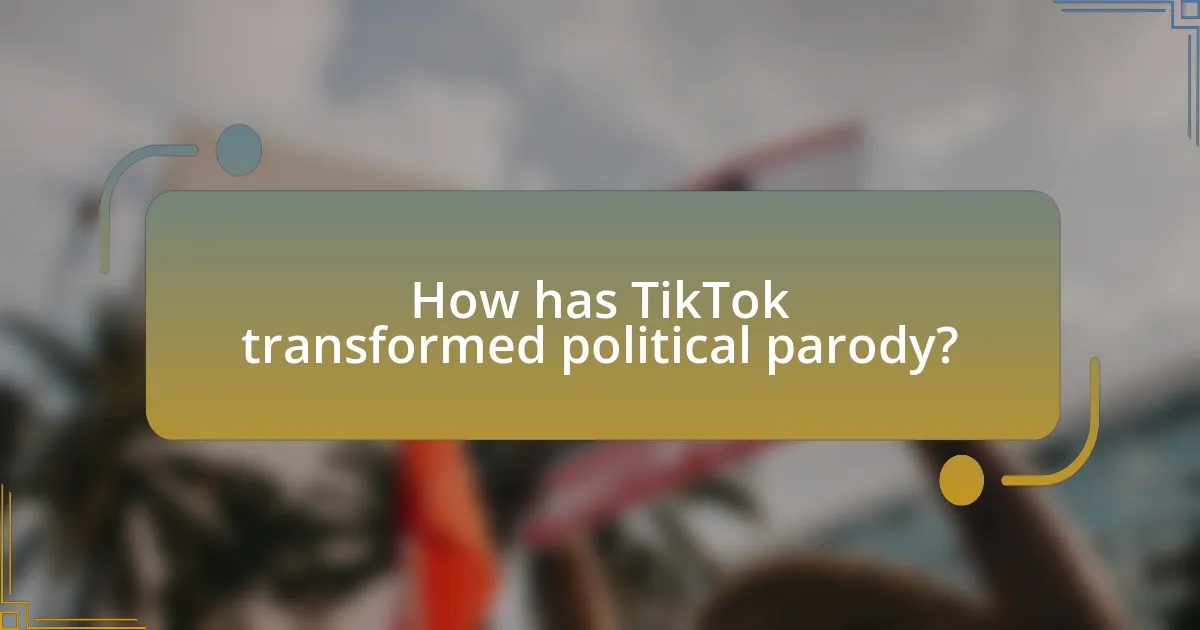
How has TikTok transformed political parody?
TikTok has transformed political parody by democratizing content creation and enabling rapid dissemination of satirical material. The platform’s short-form video format allows users to create and share humorous takes on political events quickly, reaching a vast audience in a matter of hours. This shift contrasts with traditional media, where political parody was often limited to established comedians and shows, such as “Saturday Night Live.” TikTok’s algorithm promotes viral content, allowing even amateur creators to gain visibility and influence, as seen in the popularity of videos that parody political figures or events, which can garner millions of views. This accessibility has led to a more diverse range of voices in political satire, reflecting varied perspectives and engaging younger audiences who may feel disconnected from conventional political discourse.
What unique features of TikTok facilitate political parody?
TikTok’s unique features that facilitate political parody include its short-form video format, extensive sound library, and algorithm-driven content discovery. The short video format allows creators to deliver quick, impactful messages, making it easier to satirize political figures or events in a concise manner. The extensive sound library provides users with popular audio clips, including music and sound bites, which can be creatively repurposed for comedic effect in political contexts. Additionally, TikTok’s algorithm promotes content based on engagement rather than follower count, enabling political parodies to reach a wider audience quickly, regardless of the creator’s popularity. This combination of features fosters a dynamic environment for political commentary and humor, as evidenced by viral political parodies that often gain traction rapidly on the platform.
How does the short-form video format influence the style of political parody on TikTok?
The short-form video format on TikTok significantly influences the style of political parody by promoting brevity and immediacy, which encourages creators to deliver punchy, impactful content. This format necessitates that political parodies be concise, often relying on quick wit, visual humor, and relatable references to engage viewers effectively within a limited timeframe. For instance, TikTok videos typically last between 15 to 60 seconds, compelling creators to distill complex political issues into easily digestible snippets that resonate with a broad audience. This has led to the emergence of trends such as meme-based humor and rapid-fire editing, which enhance the comedic effect and shareability of political content. The platform’s algorithm also favors engaging and entertaining content, further driving creators to adopt styles that maximize viewer retention and interaction.
What role does music and sound play in TikTok political parody?
Music and sound play a crucial role in TikTok political parody by enhancing comedic effect and facilitating audience engagement. The integration of popular songs and sound bites allows creators to juxtapose political content with familiar audio, making the material more relatable and entertaining. For instance, the use of trending audio clips can amplify the humor in a parody, as seen in videos that remix political speeches with catchy tunes, thereby increasing shareability and virality. This strategy not only captures attention but also encourages viewers to participate in the trend, further spreading the parody across the platform.
Why has TikTok become a popular platform for political parody?
TikTok has become a popular platform for political parody due to its unique blend of short-form video content, widespread accessibility, and viral potential. The platform allows users to create and share humorous takes on political events quickly, leveraging trends and challenges that resonate with a broad audience. Additionally, TikTok’s algorithm promotes engaging content, enabling political parodies to reach millions rapidly, as seen in the viral success of videos mocking political figures or events. This combination of creativity, immediacy, and community engagement has made TikTok a significant space for political satire, reflecting contemporary issues in an entertaining format.
How does TikTok’s algorithm affect the reach of political parody content?
TikTok’s algorithm significantly enhances the reach of political parody content by prioritizing engagement metrics such as likes, shares, and comments over follower count. This algorithmic focus allows content creators to reach a broader audience, as videos can go viral regardless of the creator’s existing follower base. For instance, TikTok’s “For You Page” curates content based on user interactions, which means that a politically charged parody that resonates with viewers can quickly gain traction, leading to increased visibility. Research indicates that videos with humor and satire, particularly in political contexts, tend to generate higher engagement, further amplifying their reach on the platform.
What demographic trends are evident in TikTok political parody audiences?
TikTok political parody audiences predominantly consist of younger demographics, particularly Gen Z and Millennials, who engage with political content through humor and satire. Research indicates that approximately 60% of TikTok users are aged between 16 and 24, making this age group a significant portion of the platform’s audience. Additionally, studies show that these younger users are more likely to participate in political discussions and express their views through creative formats like parody, reflecting their preference for engaging and relatable content. This trend highlights a shift in political engagement, where traditional media audiences are often older and less interactive compared to the dynamic, younger TikTok demographic.
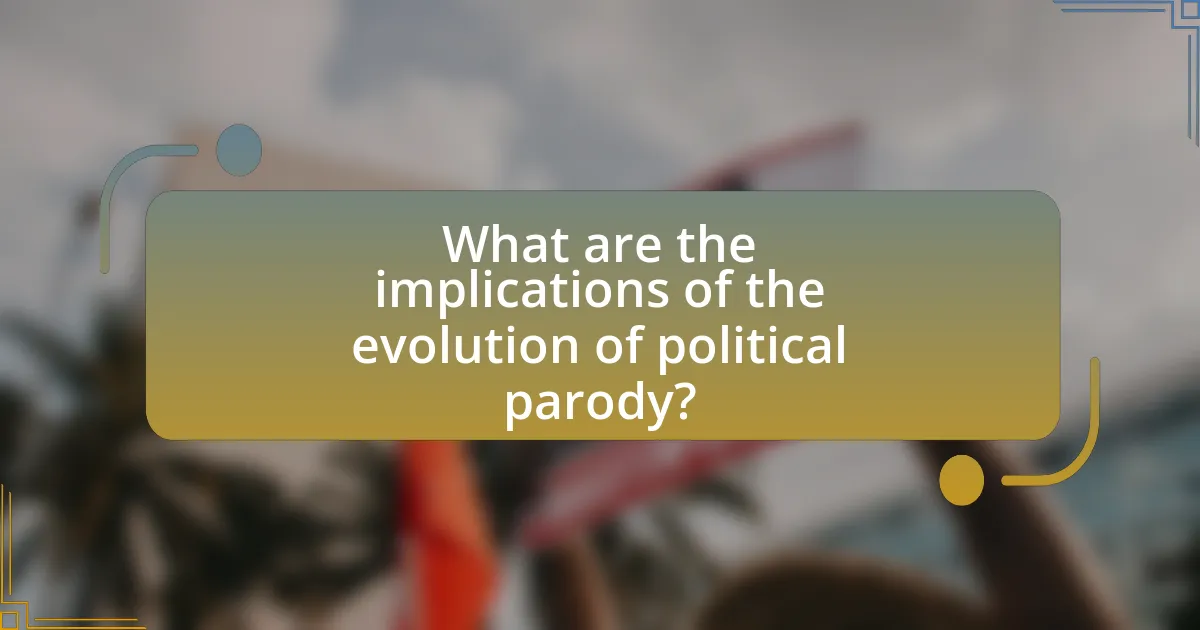
What are the implications of the evolution of political parody?
The evolution of political parody has significant implications for public discourse and political engagement. As political parody has transitioned from traditional media to platforms like TikTok, it has become more accessible and influential, allowing a broader audience to engage with political content. This shift has democratized political commentary, enabling individuals to create and share their perspectives, which can challenge mainstream narratives and promote critical thinking. For instance, the rise of short, shareable videos on TikTok has led to increased political awareness among younger demographics, as evidenced by the platform’s role in mobilizing youth voter turnout during recent elections. Consequently, the evolution of political parody not only reflects changing media consumption habits but also shapes the political landscape by fostering a more participatory and dynamic environment for political expression.
How does the shift from traditional media to TikTok affect political discourse?
The shift from traditional media to TikTok significantly alters political discourse by enabling rapid dissemination of information and fostering direct engagement between politicians and the public. TikTok’s algorithm promotes content based on user preferences, allowing political messages to reach younger audiences more effectively than traditional media, which often relies on established channels and gatekeepers. This shift has led to an increase in political parody and satire, as users create and share humorous content that critiques political figures and policies, thereby shaping public perception in real-time. For instance, during the 2020 U.S. presidential election, TikTok became a platform for viral political content, with users leveraging trends and challenges to engage in political discussions, demonstrating the platform’s role in influencing voter opinions and mobilizing activism.
What challenges does political parody face in the digital age?
Political parody faces significant challenges in the digital age, primarily due to the rapid spread of misinformation and the potential for misinterpretation. The ease of sharing content online can lead to parody being taken literally, which undermines its satirical intent. Additionally, social media platforms often implement strict content moderation policies that can restrict or remove parody content, limiting its reach and effectiveness. Furthermore, the polarized political climate can result in backlash from audiences who may not appreciate or understand the humor, leading to potential threats against creators. These factors collectively hinder the ability of political parody to engage audiences and provoke critical thought, as evidenced by numerous instances where satirical content has sparked controversy rather than dialogue.
How can political parody be used responsibly in modern media?
Political parody can be used responsibly in modern media by ensuring it promotes critical thinking and informed discourse rather than spreading misinformation. Responsible political parody should clearly distinguish between satire and factual reporting, allowing audiences to recognize the comedic intent while encouraging them to engage with the underlying political issues. For instance, programs like “Saturday Night Live” often use parody to highlight political absurdities, which can stimulate public discussion and awareness about important topics. This approach is supported by research indicating that satire can enhance political engagement among viewers, as shown in studies published in the Journal of Communication, which found that exposure to political satire increases knowledge and interest in political affairs.
What best practices can creators follow when producing political parody?
Creators producing political parody should prioritize clarity, humor, and relevance to effectively engage their audience. Clarity ensures that the message is easily understood, while humor can enhance the impact of the parody, making it more shareable. Relevance to current events or political issues increases the likelihood of resonating with viewers, as seen in successful parodies that reflect ongoing political discourse. For instance, shows like “Saturday Night Live” have effectively used these principles to create memorable political sketches that spark conversation and critique.
How can creators balance humor and sensitivity in political parody?
Creators can balance humor and sensitivity in political parody by carefully considering the context and potential impact of their content. This involves understanding the audience’s perspectives and the nuances of the political issues being addressed. For instance, creators can employ satire that critiques policies or actions rather than targeting individuals, which reduces the risk of personal offense. Research indicates that effective political humor often relies on shared values and experiences, allowing audiences to engage without feeling alienated. By focusing on relatable themes and employing clever wordplay or absurdity, creators can maintain humor while fostering a respectful dialogue around sensitive topics.
What strategies can enhance the effectiveness of political parody on social media?
To enhance the effectiveness of political parody on social media, creators should focus on timely relevance, audience engagement, and shareability. Timely relevance ensures that the parody addresses current events or trending topics, making it more relatable and impactful; for instance, parodies that respond to recent political speeches or controversies tend to gain more traction. Audience engagement can be achieved through interactive elements, such as polls or comments, which encourage viewers to participate and share their opinions, thereby increasing visibility. Shareability is crucial, as content that is easily shareable—due to humor, brevity, or visual appeal—tends to spread rapidly across platforms, amplifying its reach. Research indicates that content that resonates emotionally, particularly through humor, is more likely to be shared, thus reinforcing the importance of these strategies in maximizing the effectiveness of political parody on social media.
